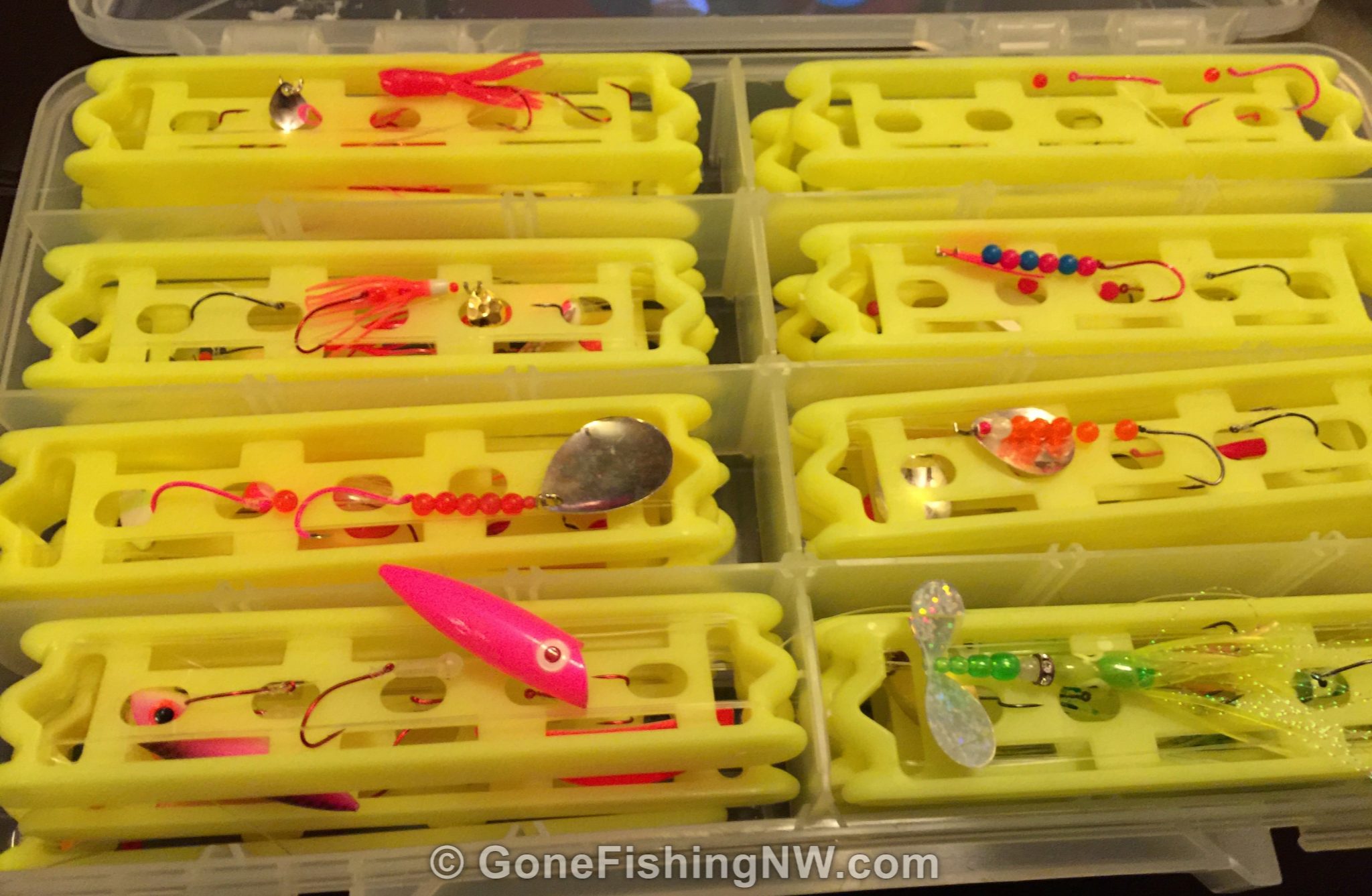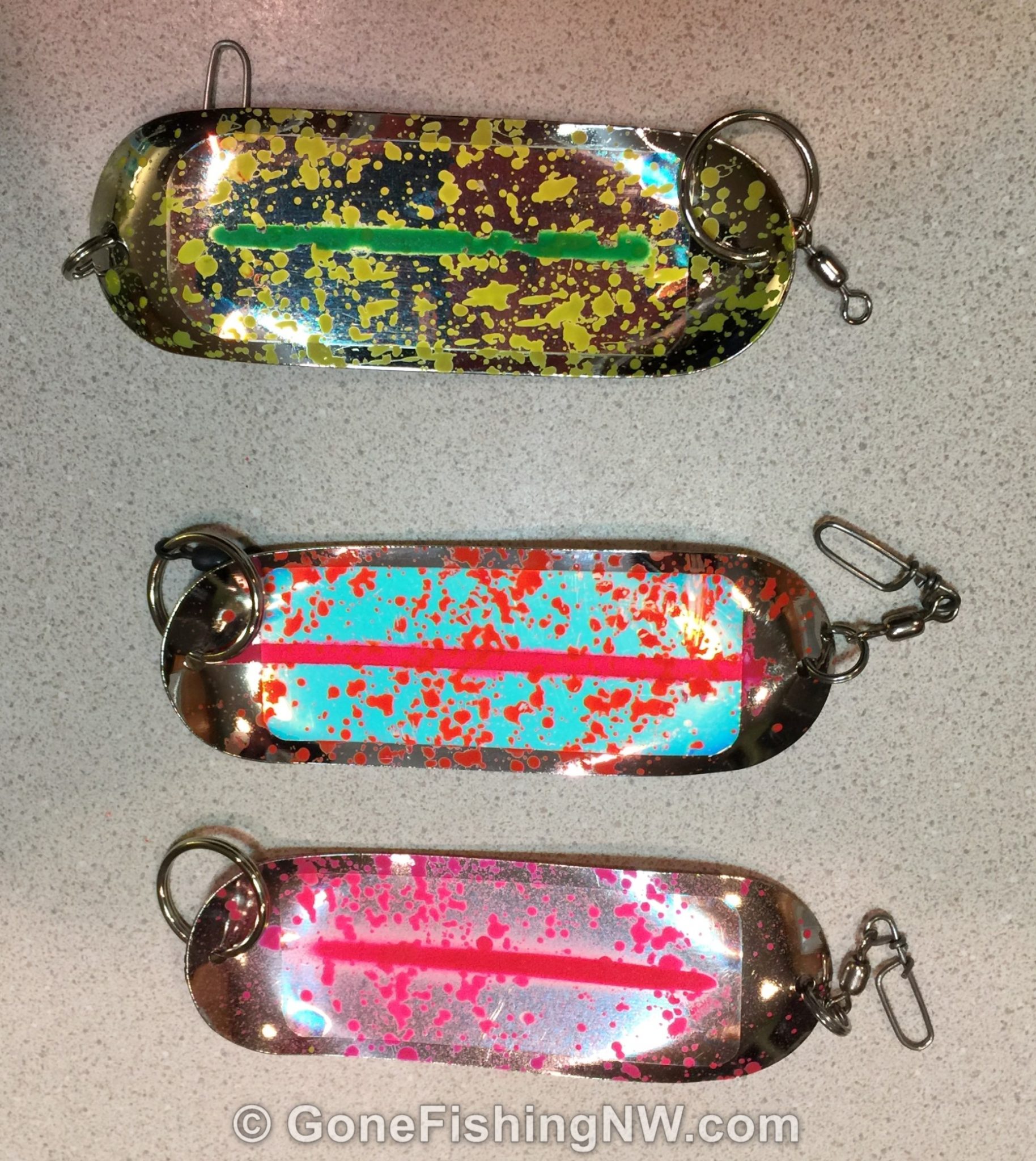Kokanee are a land locked sockeye salmon. Most places they grow to be trout sized – 10-14 inches, but some lakes they can rival their sea going brothers.
They are fun to fish for, and very tasty to eat.
This article is intended as a “Get Started” guide to start you on your journey to become an expert kokanee angler.
Rod & Reel
If you have a light trout rod then it will likely do OK for kokanee. However most prefer a rod made for kokanee downrigger fishing. The reason is that kokanee have really soft mouths – so having a really light and slow action rod can absorb their head shakes and prevent the hooks from tearing free.
Many rod makers have a rod that is actually labeled for kokanee. One of my favorites is the Lamiglas kokanee rod. You’ll want to pair it with a casting reel appropriately sized with a good drag, like the Abu Garica Black Max.
I then spool mine with 10 pound Power Pro depth hunter line, with a 10 foot top shot of 8 pound fluorocarbon.
Don’t forget to set the drag appropriately, and keep in mind the tips for dealing with braid.
Tackle
For tackle there are a few choices, but my favorite is homemade beaded spinners behind a 4/0 dodger.
The dodgers are about 4 inches long and there are a number of companies that make them, like Dick Nite, Vance Tackle and Seps. You’ll also find they come in what seems to be a hundred colors and patterns.
To start off I recommend getting a few in the standard colors of chrome, 50/50 and pink splatter. As time goes on you’ll find yourself buying a few dozen dodgers for these finky fish. Here are my favorites:
Next for the spinners. You can buy them pre-made, but I think it is both cheaper and more fun to tie your own. I tie them on 15 pound fluorocarbon line. Start by tying 2 hooks fairly close together. Then add some beads. And top the whole thing off with a spinner blade attached via a clevis.
Tying your own is much cheaper than buying them pre-tied – especially if you want multiple setups.
My standard is to use size 2 or 4 pink hooks, then about 5 red beads – 4 or 5mm – then a gold or silver spinner. The result looks like this:
Although sometimes I do like to switch up the colors…
For spinner blades I like the traditional Colorado style in sizes 2 to 4. I believe that the gold and silver plated ones work best, especially the hammered style.
Rigging It Up
When I put the rig together I have my rod setup with my Simple Trolling Rig. I attach the dodger to the snap.
Then I tie a loop knot on the end of the leader – making the leader between 8 to 12 inches long from bottom of the hook to the top of the loop. I then put the loop in the snap on the bottom of the dodger.
I often smear the dodger with some kind of gel scent. The Kokanee DNA scent is my favorite.
Then I’ll put a kernel of white shoepeg corn on each hook, like this:
You can use the corn right out of the can, but often it is good to marinate the corn overnight in some additional scents. Garlic often works well.
Start Fishing
With the boat in gear you then start letting your gear out. Don’t forget to take a look at it working in the water. The spinner should be spinning, and the dodger wobbling back and forth. In addition the dodger should be causing the spinner to move around a little erratically as it wobble. If it doesn’t work right, then bring the gear in and tweak it until it does work right.
Let out some line, and attach it to the downrigger. Lower the downrigger ball to the desired depth and start trolling around.
As a general rule, try and follow the “Rule of 100.” That is 100 feet of line out total. So, for example, if you were going to fish 30 feet down, then first you let out 70 feet of line. Attach it to the downrigger clip, and lower it down to 30 feet. 70 + 30 = 100 feet of line.
Make sure to reel in all the slack and have that rod with a nice tight bend so you can see the strike.
Trolling speed should be around 1.0-1.2MPH, but sometimes they like it a little faster or slower. So if you aren’t getting bites, then experiment. Sharp S-curves while trolling can often trigger a strike as your gear changes speed.
Fighting the Fish
When a fish strikes, you’ll want to:
- Grab the rod.
- Reel down until the rod tip is near the water.
- Place one hand above the reel and grip both the line and rod – this will keep the drag from slipping out
- Give the rod a good yank up – like a hookset. Keep the rod high while you take the slack out of the line.
- Once everything is tight you can lower the rod and reel in the fish
Given the softness of the mouth, you should take your time reeling in. If the fish is actively fighting back, then slow down – or even stop – your reeling until it is done. Just keep enough pressure to have the line be tight.
Once the fish is close to the boat it normally freaks out. Let it do its thing, and then net it head first.
Kokanee Behavior
Now that we’ve covered the fishing mechanics we can talk a little bit about fish behavior.
Kokanee are notorious early morning biters. So being on the water early can be critical.
You’ll generally find them around the thermocline. If the day is cloudy and overcast then they might come up a little. If it is bright and sunny they might go down a little deeper – especially later in the day.
I like to focus on points and drop offs, however they tend to like lots of water under them, so they are also will be places where the water is deeper.
They are schooling fish, so once you find them keep trolling in that general area to pick up more.
Summary
As with all fishing there is a lot more information and experience that goes into becoming a master. But this little explanation should be enough to get you started and catching a few fish. Best of luck to you and tight lines!













